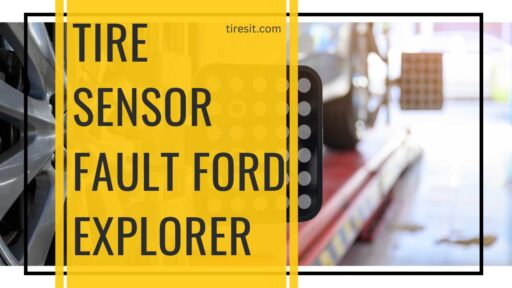Hitting the road, all set for a long journey, and suddenly, your Tire sensor fault Ford Explorer dashboard lights up with the dreaded “Tire Sensor Fault” message – what a way to put a dent in your travel plans! But don’t let this small bump on your road trip ruin your experience. We know how this frustrating error can drive any car owner to their wit’s end, especially when you don’t exactly know what it means or where to start troubleshooting.
In this article, we will guide you through what it means when your Ford Explorer’s tire sensor is reading as faulty, the common causes of this problem, and the solutions to get your ride back on the road. Imagine this as your friendly neighbor who always knows how to fix your car issues, available right within your grasp! Let’s buckle up and conquer the road ahead without fearing the dreaded “Tire Sensor Fault.”
“Tire sensor fault isn’t just a message; it’s a call to attention. Your car is asking for a little care. It’s a bond, a lifelong relationship, one mile at a time.”
Understanding the Role of the Tire Sensor in Your Tire Sensor Fault Ford Explorer
Imagine for a moment you’re driving, and a little light pops up on your dashboard. It’s no ordinary light; rather, it’s the tire pressure monitoring system (TPMS) light, a light that acts as an early-warning system of potential tire sensor faults. This light is your Ford Explorer, essentially saying, “Hey there, something’s not quite right with the tire pressure sensor. We should check it out.”
Age, in human years or sensor years, is always a factor. For tire pressure sensors, aging can lead to reduced functionality and, ultimately, failure. After years of exposure to heat, cold, and constant pressure changes, the efficiency of your TPMS might decline, which eventually leads to a sensor fault.
The common foes of anything metal, such as corrosion, are often a significant instigator of sensor faults. Regardless of how well-crafted your vehicle is, components like tire pressure sensors can fall victim to water intrusion and various types of corrosion, leading to system prompt malfunctions or failures. address
Then there’s the issue of faulty wiring, a small but significant troublemaker that can trigger sensor faults. Wiring might seem like a mundane detail in the grand scheme of Ford Explorer parts, but even a small short-circuit or broken wire can disrupt the stability of the whole tire pressure monitoring system.
Knowing the warning signs and potential causes of sensor faults can potentially save you from costly repairs in the future. Using tools like a tire pressure gauge or a TPMS scan tool, you can keep track of the health of your sensors and catch any issues early on before they escalate.
Additionally, regularly inspecting the physical condition of your sensors can help prevent water intrusion and corrosion. Make sure to also check for any loose wires or connections that may be causing disruptions in the system.
In some cases, replacing the sensors altogether may be necessary if they have become too damaged. It’s important to always use high-quality OEM (original equipment manufacturer) sensors for replacements to ensure proper functionality and compatibility with your Ford Explorer.
By staying vigilant and addressing sensor issues promptly, you can ensure that your tire pressure monitoring system stays reliable and effective for years to come.

Credit: www.pexels.com
Step-by-Step Guide: Fixing the Tire Sensor Fault in Your Ford Explorer
A tire sensor fault is not just an alert on your dashboard but can be a warning of potential danger. So, it’s important to understand the mechanisms involved and how to properly respond. Before we delve into the steps, equip yourself with tools like a tire pressure gauge and a scan tool to help accurately diagnose the issue.
One common culprit is age. Sensor age plays a critical role in tire sensor faults. Over time, sensors fatigue and lose their functionality, leading to inaccurate readings and faults. In such cases, replacement is usually the best solution.
Corrosion is another dominant issue affecting the health of tire sensors. It can impact the mechanical parts of the sensor, leading to inaccurate pressure readings. This would also call for a sensor replacement. And, while this may seem daunting, you can often complete this task at home, following manufacturer guidelines to ensure correctness.
At times, faulty wiring is to blame. Remember, in your Ford Explorer, these sensors are part of a broader Tire Pressure Monitoring System (TPMS). Faulty wiring within this system can trigger tire sensor faults thus, a deeper inspection may be necessary.
Now, let’s go step-by-step through a general process of tackling a tire sensor fault:
- Start by checking the battery voltage. A failing or weak battery could cause a false alarm.
- If the battery is in good shape, use your scan tool to reprogram or reset the sensor.
- Manually inspect components like the valve stem and speed sensors for signs of wear, corrosion, or other potential issues.
- If all else fails, consider replacing the faulty sensor with the right replacement part, following the manufacturer’s guidelines.
Maintaining and monitoring your tire pressure on a regular basis is key to pre-empting these faults. Owning a Ford Explorer means dealing with occasional tire pressure sensor faults. Although they might be a common issue, addressing them promptly will ensure the sustained performance and safety of your vehicle.
Troubleshooting 101: How to Diagnose Tire Sensor Faults
Think of troubleshooting your tire sensor faults like solving a mystery. First, you arm yourself with the tools necessary to uncover any hidden issues, and then you go on to investigate! In the case of your Ford Explorer, one tool you’d find handy is a tire pressure gauge or a scan tool. These can help in detecting incongruences in the tire pressure that might hint at a sensor issue.
Here’s the scoop: faulty wiring can be a prime suspect behind a tire pressure sensor fault. Older sensors are more prone to have suffered wear and tear, making sensor age a pivotal factor in identifying the issue. Checking both these factors could provide you valuable clues to what’s going wrong.
Get this: corrosion is like the masked villain in our story, quite often the one responsible for tire sensor faults. It can easily jeopardize the sensors, leading to failure. Therefore, make sure your detective’s eyes don’t overlook any such sneaky perpetrators.
Not dealing with these issues could adversely affect your vehicle’s performance and your safety, given that the Tire Pressure Monitoring System (TPMS) plays a vital role in your vehicle’s functioning. The great news is that regular maintenance, keeping an eye on your tire pressure, and following manufacturer guidelines for sensor replacements can prevent future TPMS faults.
Apart from inspecting the above elements, here are the steps to fix a bad TPMS sensor: start by checking the battery voltage. Next, reprogram or reset the sensor. If the fault persists, it could mean the sensor needs replacement. Upon replacement, remember to stay in compliance with the regulations in place. It’s a small step but one that goes a long way in ensuring your vehicle continues running at its very best.
The Impact of Climate and Terrain on Your Ford Explorer’s Tire Sensors
Living in regions with temperature fluctuations, like southern Illinois, can considerably affect your Ford Explorer’s TPMS system. Yes, believe it or not, your vehicle’s tire sensors are quite susceptible to external environmental factors, and changes in climate are certainly one of them. As the temperature drops or significantly increases, tires tend to contract or expand, respectively. These variations can inadvertently trigger the TPMS, resulting in a false alarm of low or high tire pressure.
Moreover, different terrains also play a role in the performance of your tire sensors. Rocky or undulating landscapes can cause physical damage to the tire sensors, increasing the likelihood of a fault. Likewise, driving through water-laden areas can lead to corrosion, another common culprit behind tire pressure sensor faults. When these corrosive elements adhere to the tire sensor, it can impact its ability to send accurate signals to the TPMS system.
Exemplifying this, consider your Ford Explorer regularly traversing through rough, challenging terrains filled with snow, water, or rock. It’s a thrilling experience, undoubtedly! While this may seem like a fantastic adventure, it can be tough on your vehicle’s tire sensors. All those bumps, shocks, and exposure to moisture can lead to rapid wear and tear of the sensor, potentially leading to a fault.
So, how do you minimize these effects? Well, regular maintenance is key here. Inspect your tire sensors routinely, especially when changing seasons or if you’ve been on challenging terrains. Ensure to address any sensor faults promptly to ensure your well-being and maintain your vehicle’s performance. Remember, your tire pressure sensors are not just pieces of technology, but watchful guardians ensuring a safe and smooth ride!
Decoding Ford Explorer’s Tire Sensor Fault Messages
When driving your Ford Explorer, sometimes, you may encounter an unsettling but somewhat cryptic message pop up on your dashboard – a “Service Tire Pressure System” error. This error message signals a tire sensor fault, often sending car owners into a spell of confusion.
Despite the alarm, it’s interesting to note that this error can sometimes be misleading. Yes – not every error message signals fault with your tire sensor system. In fact, at times, your sensors might be working perfectly, yet this error message persists. In such scenarios, it’s usually the wiring system triggering the error, not the sensors themselves. Sounds tricky, doesn’t it? However, understanding these nuances can help dispel worry and guide your way to targeted solutions swiftly.
Age is an undeniable factor here as well. Like every other aspect of your vehicle, tire pressure sensors also age and become less efficient over time. This age-induced inefficiency may come across as faulty functioning, setting off those alarm bells. Therefore, regular checks and timely maintenance become crucial.
Also, it’s essential to remember that corrosion is often a silent culprit behind these error messages. A victim of wear and tear or exposure to harsh conditions might result in corroded sensors triggering false alarms.
Bearing all this in mind, addressing tire pressure sensor faults promptly is not just about fixing the issue at hand. It also signifies compliance with vehicular regulations. Furthermore, recognizing and resolving these issues ensures your safety and enhances overall vehicle performance.
When dealing with tire pressure sensor faults, a blend of technological innovations such as scan tools and manual methods like a tire pressure gauge can prove to be highly effective. As a lot of car owners can attest to, such faults are an everyday struggle. So, next time your dash throws a tire sensor fault your way, remember, it’s a common issue, one that with knowledge and the right tools, can be decoded and resolved.
Frequently Asked Questions
Let’s tackle some of those buzzing questions in your mind about the tire sensor fault in your Ford Explorer.
Do extreme weather conditions impact my Ford Explorer’s tire sensor?
Absolutely! Extreme temperatures, both hot and cold, can significantly affect the tire sensors in your vehicle. Particularly, in winter and summer, you can expect to encounter sensor faults. Make sure to park in shaded areas during scorching weather and ensure proper insulation during freezing conditions to prevent potential issues.
Can ignoring the tire sensor fault lead to penalties?
Indeed, it can. Abiding by vehicle safety regulations is not only crucial for your safety but also a legal obligation. Failure to address these faults may result in penalties or fines. Always adhere to safety guidelines for a trouble-free driving experience.
How can I prevent a tire sensor fault in my Ford Explorer?
Preventive measures come to the rescue here! Regular maintenance, timely diagnosis, and proper resetting procedures can keep those tire sensor faults at bay. Also, periodic checks can help detect any wiring issues early, preventing higher damages.
Can tire sensor faults provide real-time information?
Yes, they can. The tire sensors offer real-time insights into the condition of your tires. Paying attention to these real-time updates helps you take quick action whenever necessary, ultimately ensuring smooth and safe rides.
Remember, extensive research into these faults can help you identify warning signs and take necessary action in time. Stay informed, stay safe!
Conclusion of Tire Sensor Fault Ford Explorer
In conclusion, tire sensor faults are a common issue that many vehicle owners face. However, with the right knowledge and preventive measures, they can easily be managed and even avoided altogether. Regular maintenance and checks, along with paying attention to real-time updates from the sensors, will ensure safe and smooth rides for you. So always stay informed about your vehicle’s condition and take necessary action when needed. With these tips in mind, you can say goodbye to tire sensor faults and enjoy worry-free driving experiences.





